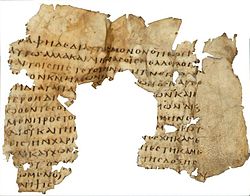Description
Uncial 0220 measures 8,1 by 11cm. There are 14 lines to a page. The recto (4:23-5:3) is legible, but little can be made out on the verso (5:8-12). The scribe wrote in a reformed documentary hand.
The Alands describes the text-type as "strict".
Uncial 0220 is an important early witness to the Alexandrian text-type, agreeing with Vaticanus everywhere except Rom. 5:1. [2] (See Below) It is classed as a "consistently cited witness of the first order" in the Novum Testamentum Graece. [3] NA27 considers it even more highly than other witnesses of this type. It provides an exclamation mark (!) for "papyri and uncial manuscripts of particular significance because of their age." [4]
The manuscript has evidence of the following nomina sacra: ΚΝ, ΙΥ, ΙΝ, ΧΥ, ΘΥ.
Rom. 5:1: [3]
εχομεν: א1 B2 F G P Ψ 0220vid. 104. 365. 1241. 1505. 1506. 1739c. 1881. 2464. l 846 pm vgmss
εχωμεν: א* A B* C D K L 33. 81. 630. 1175. 1739* pm lat bo; McionT
History
Currently it is dated by the INTF to the 3rd century. [5]
It was purchased in Cairo in 1950 by Leland C. Wyman, [6] a professor of biology at Boston University. Later part of it was bought by Martin Schøyen and now part of it is housed in the Martin Schøyen Collection in Oslo, and part in London. In 2012 this text was purchased at a Sotheby's auction by the Green Collection. [7] It will be on the display at the Museum of the Bible in Washington, D.C. [1]
The text was published by William Hatch in the Harvard Theological Review in 1952.
This page is based on this
Wikipedia article Text is available under the
CC BY-SA 4.0 license; additional terms may apply.
Images, videos and audio are available under their respective licenses.
